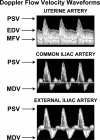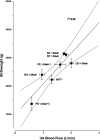High-end arteriolar resistance limits uterine artery blood flow and restricts fetal growth in preeclampsia and gestational hypertension at high altitude
- PMID: 21325643
- PMCID: PMC3094033
- DOI: 10.1152/ajpregu.91046.2008
High-end arteriolar resistance limits uterine artery blood flow and restricts fetal growth in preeclampsia and gestational hypertension at high altitude
Abstract
The reduction in infant birth weight and increased frequency of preeclampsia (PE) in high-altitude residents have been attributed to greater placental hypoxia, smaller uterine artery (UA) diameter, and lower UA blood flow (Q(UA)). This cross-sectional case-control study determined UA, common iliac (CI), and external iliac (EI) arterial blood flow in Andeans residing at 3,600-4,100 m, who were either nonpregnant (NP, n = 23), or experiencing normotensive pregnancies (NORM; n = 155), preeclampsia (PE, n = 20), or gestational hypertension (GH, n = 12). Pregnancy enlarged UA diameter to ~0.62 cm in all groups, but indices of end-arteriolar vascular resistance were higher in PE or GH than in NORM. Q(UA) was lower in early-onset (≤34 wk) PE or GH than in NORM, but was normal in late-onset (>34 wk) illness. Left Q(UA) was consistently greater than right in NORM, but the pattern reversed in PE. Although Q(CI) and Q(EI) were higher in PE and GH than NORM, the fraction of Q(CI) distributed to the UA was reduced 2- to 3-fold. Women with early-onset PE delivered preterm, and 43% had stillborn small for gestational age (SGA) babies. Those with GH and late-onset PE delivered at term but had higher frequencies of SGA babies (GH=50%, PE=46% vs. NORM=15%, both P < 0.01). Birth weight was strongly associated with reduced Q(UA) (R(2) = 0.80, P < 0.01), as were disease severity and adverse fetal outcomes. We concluded that high end-arteriolar resistance, not smaller UA diameter, limited Q(UA) and restricted fetal growth in PE and GH. These are, to our knowledge, the first quantitative measurements of Q(UA) and pelvic blood flow in early- vs. late-onset PE in high-altitude residents.
Figures





References
-
- Bosio P, McKenna P, Conroy R, O'Herlihy C. Maternal cental hemodynamics in hypertensive disorders of pregnancy. Obstet Gynecol 94: 978–984, 1999 - PubMed
-
- Bower S, Bewley S, Campbell S. Improved prediction of preecalmpsia by two-stage screeening of uterine arteries using the early diastolic notch and color Doppler imaging. Obstet Gynecol 82: 78–83, 1993 - PubMed
-
- Brosens IA, Robertson WB, Dixon HG. The role of the spiral arteries in the pathogenesis of preeclampsia. Obstet Gynecol Annu 1: 177–191, 1972 - PubMed
Publication types
MeSH terms
Grants and funding
LinkOut - more resources
Full Text Sources
Medical
Miscellaneous

